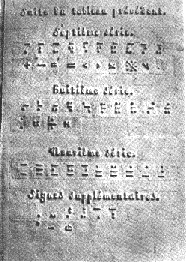
Home
Search!
Session Topics
Modifiers- Part I
Modifiers- Part II
Multipurpose Indicator
Miscellaneous Symbols- Part I
Miscellaneous Symbols- Part II
Evaluation
Writing Exercise
Other Resources
Contact instructor
Send mail to class
Main BRL page
Contractions Lookup
Contractions List
Intro Braille course
Transcribers course
|
Modifiers and Modified Expressions |
|
Definition: A modifier is a symbol or combination of symbols occurring directly over or under its related symbol or expression.

The most commonly used modifiers are listed below. Other symbols of the code may also be used as modifiers.
| Modification Indicators |
| Multipurpose Indicator |
 |
| Directly-Over Indicator |
 |
| Directly-Under Indicator |
 |
| Termination Indicator |
 |
|
| Modifiers-Arc |
| Concave Upward |
 |
  |
| Concave Downward |
 |
  |
|
| Modifiers-Arrow |
| Barbed at Right |
| Contracted Form |
 |
 |
| Uncontracted Form |
 |
 |
|
| Barbed at Left |
 |
 |
| Barbed at Both Ends |
 |
 |
Barbed at Right and
Dotted at Left |
 |
 |
Barbed at Left and
Dotted at Right |
 |
 |
Dotted at Right
(no barb) |
 |
 |
Dotted at Left
(no barb) |
 |
 |
Dotted at
Both Ends |
 |
 |
| Hollow Dot at Right (no barb) |
 |
 |
| Hollow Dot at Right and Barb at Left |
 |
 |
| Hollow Dot at Left (no barb) |
 |
 |
| Hollow Dot at Left and Barb at Right |
 |
 |
| Hollow Dot at Both Ends |
 |
 |
|
| Modifiers-Bar |
| Horizontal (macron) |
_ |
 |
| Vertical |
| |
 |
|
| Modifiers-Caret |
| Circumflex |
 |
  |
| Inverted |
 |
  |
| Left-Pointing |
 |
  |
| Right-Pointing |
 |
  |
|
| Modifiers-Dot |
  |
| Hollow Dot |
   |
| Question Mark |
 
 |
| Tilde |
|
| Triangle (equilateral) |
   |
Construction of Simple Modified Expressions:
- The Five Step Rule:
The following five-step rule must be used for the transcription of a modified expression. (see exception in C below.)
The mutipurpose indicator must be placed immediately before the expression to be modified. must be placed immediately before the expression to be modified.
The expression to be modified must be written second.
The directly-over indicator  or the directly-under indIcator or the directly-under indIcator must be written third to show the position of the modifier. must be written third to show the position of the modifier.
The modifying symbol must be written fourth.
The termination indicator  must be written last to show the end of the modification. must be written last to show the end of the modification.
The spacing before and after a modified expression is subject to the spacing rules for the symbols preceeding or following it. Two or more symbols in a modifier must be placed in accordance with their appropriate spacing rule.


































































- Contracted Form of Modified Expressions:
When a single digit or a single letter (in any type form or any alphabet) is modified only by a single horizontal bar directly over it, the symbol for the bar must be placed immediately after the digit or letter modified, and the five-step rule must not be used. In all other cases, the five-step rule in a above must be applied.




































- Binomial Coefficient:
does not follow the five-step rule for modified expressions. The directly-under indicator  Separates the two expressions composing the binomial coefficient. That is, the opening parenthesis is followed by the upper expression. The directly-under indicator is placed next and is followed by the lower expression and the closing parenthesis. Separates the two expressions composing the binomial coefficient. That is, the opening parenthesis is followed by the upper expression. The directly-under indicator is placed next and is followed by the lower expression and the closing parenthesis.




Expressions with more than one modifier:
When two or more modifiers occur one above the other and apply to exactly the same expression, the second, third, etc. modifiers are "modifiers of higher order." In such cases, the directly-over indicator  or the directly-under indicator or the directly-under indicator  must be doubled, tripled, etc. before each modifier to indicate its position. The termination indicator must be doubled, tripled, etc. before each modifier to indicate its position. The termination indicator  must be used only after the last modifier shown. must be used only after the last modifier shown.




Exception: When two or more parallel horizontal bars are the same length and apply to exactly the same expression, they must be treated as a single modifier. In such cases, the directly-over or the directly- under indicator must be used only once, and the symbol for the bar should be used as many times as necessary to correspond to the print text.
Note: Two parallel horizontal bars must not be interpreted as the equals sign, and three parallel horizontal bars must not be interpreted as the identity sign unless they occur above or below a sign of comparison. In such cases, the combination must be treated as a sign of comparison compounded vertically.
3. 

4. 

5. 

6. 

7. 

When two or more modifiers do not apply to exactly the same symbols but cover different portions of the same expression, the longer modification must enclose the entire modified expression, and each inner expression must be modified individually. The five-step rule and the contracted form of transcription may be used together.








Simultaneous Modifiers: When an expression is simultaneously modified both above and below, the modifier below must be shown first and the modifier above, second. However, the termination indicator must be used only at the end of the entire modification.
























Go to Modifers, Part II
|
|

